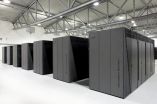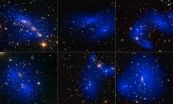(Press-News.org) Dark matter is one of science's great mysteries. It makes up an enormous amount matter in the universe, it is invisible, and it does not correspond to anything in the realm of our experience. Different theories compete for an explanation, but so far none of them has prevailed. In a collaborative study between École Polytechnique Fédérale de Lausanne (EPFL) and the University of Edinburgh, scientists have studied how dark matter behaves when galaxy clusters collide with each other over billions of years. Published in Science, their findings challenge at least one major theory on dark matter.
Dark matter and galaxy clusters
Although it accounts for 90% of all matter in the universe and more than a quarter of its energy, we know very little about dark matter. One major idea among astronomers is that dark matter consists of a new subatomic particle that we haven't discovered yet. More exotic theories want dark matter to be a quantum defect from the birth of the universe, extra-dimensional mass, and even a modified form of gravity.
What we do know is that dark matter interacts with cosmic structures through gravity, shaping and molding them. For example, dark matter bends light that passes through it, distorting images of distant space objects. In addition, dark matter speeds up the motion of galaxies inside galaxy clusters, which are collections of hundreds of galaxies, containing literally astronomical amounts of stars, planets, and gases. Galaxy clusters are also 90% dark matter, which makes them ideal for studying it, especially when they collide into each other and force their respective dark matters to interact.
Peering into the dark
David Harvey at EPFL's Laboratory of Astrophysics studies galaxy cluster collisions to find clues about the nature of dark matter. Continuing his PhD work from the Royal Observatory at Edinburgh, he and his colleagues studied data from 72 galaxy cluster collisions. These cosmic crashes happen over the course of billions of years when galaxy clusters attract each other because of their gargantuan masses. When this happens, the dark matter in each galaxy cluster interacts with that of the other, offering a unique opportunity to study it.
Harvey's data came from the Chandra X-ray Space Observatory and the Hubble telescope, and included the famous Bullet Cluster collision, a collision of two galaxy clusters whose gas has been molded into the shape of a bullet. This particular collision is actually the best current evidence for the existence of dark matter.
The researchers analyzed the collision data to measure the change in momentum of dark matter when two galaxy clusters crashed into each other. Experiments on Earth, e.g. in the Large Hadron Collider, show us that when subatomic particles interact, they exchange momentum. Therefore, depending on what happened to the dark matter after the collision, the researchers could draw conclusions about its nature.
To test the theory that dark matter consists of particles, the study worked with two possible scenarios: Either the particles of the dark matter interacted frequently but exchanged little momentum, or they interacted rarely but exchanged a lot of momentum. In the first case, dark matter would slow down after the collision, because the frequent particle interactions would cause an additional "drag". In the second scenario, dark matter would tend to be scattered away and lost into space.
Surprisingly, the study discovered that dark matters in galaxy cluster collisions simply pass through each other. This implies that dark matter particles do not interact with themselves, which would have caused dark matter to slow down. Instead, it appears that while dark matter could interact "non-gravitationally" with visible matter, this is not the case when it interacts with itself.
More importantly, the study challenges the view that dark matter consists of proton-like particles - or perhaps any particles whatsoever. "We have now pushed the probability of two 'dark matter particles' interacting below the probability of two actual protons interacting, which means that dark matter is unlikely to consist of just 'dark-protons'," says David Harvey. "If it did, we would expect to see them 'bounce' off each other".
INFORMATION:
This work represents a collaboration of EPFL's Laboratory of Astrophysics with the Royal Observatory at the University of Edinburgh, the Institute for Computational Cosmology at Durham University, and the Mullard Space Science Laboratory at University College London.
Reference
Harvey D, Massey R, Kitching T, Taylor A, Tittley E. The non-gravitational interactions of dark matter in colliding galaxy clusters. Science 27 March 2015. DOI: 10.1126/science.1261381
Foraging bats obey their own set of 'traffic rules', chasing, turning and avoiding collisions at high speed, new research from the University of Bristol, UK has found.
Dr Marc Holderied of Bristol's School of Biological Sciences studied pairs of Daubenton's bats (Myotis daubentonii) foraging low over water for stranded insects at a site near the village of Barrow Gurney in Somerset, UK.
He said: "Collective movements of flocking birds or shoaling fish are amongst the most fascinating natural phenomena, and everyone has experienced the challenges of walking through ...
CHAPEL HILL, NC - A team of researchers has discovered HIV can begin replicating in the brain as early as four months after initial infection. The study followed 72 treatment naïve participants during the first two years of HIV infection. Through analysis of cerebral spinal fluid (CSF) and blood samples, 20 percent of subjects showed replication in the central nervous system (CNS) at four months. Additionally, 30 percent of participants showed evidence of a marked CSF inflammatory response in at least one time point and 16 percent of study volunteers showed a marked ...
The fact that the neutron is slightly more massive than the proton is the reason why atomic nuclei have exactly those properties that make our world and ultimately our existence possible. Eighty years after the discovery of the neutron, a team of physicists from France, Germany, and Hungary headed by Zoltán Fodor, a researcher from Wuppertal, has finally calculated the tiny neutron-proton mass difference. The findings, which have been published in the current edition of Science, are considered a milestone by many physicists and confirm the theory of the strong interaction. ...
Astronomers using observations from the NASA/ESA Hubble Space Telescope and NASA's Chandra X-ray Observatory have studied how dark matter in clusters of galaxies behaves when the clusters collide. The results, published in the journal Science on 27 March 2015, show that dark matter interacts with itself even less than previously thought, and narrows down the options for what this mysterious substance might be.
Dark matter is a giant question mark looming over our knowledge of the Universe. There is more dark matter in the Universe than visible matter, but it is extremely ...
Say you're out shopping for basic household goods -- perhaps orange juice and soup. Or light bulbs. Or diapers for your young child. How do you choose the products you buy? Is it a complicated decision, or a simple one?
It could be complex: Factors like price, quality, and brand loyalty may run through your mind. Indeed, some scholars have developed complicated models of consumer decision-making, in which people accumulate substantial product knowledge, then weigh that knowledge against the opportunity to explore less-known products.
But in a new paper, MIT researchers ...
(WASHINGTON - March, 26, 2015) - A committee of lymphoma experts today unveiled a strategic roadmap identifying key priority areas in both infrastructure and research that will be critical for advancing treatments for people with lymphoma. The report is meant to inform future research directions as well as funding decisions by strategic partners that could include government agencies and the private sector. The strategic recommendations were developed after a review of the state of the science in lymphoma conducted at a special ASH Meeting on Lymphoma Biology held in August ...
EAST LANSING, Mich. -- It may sound like the makings of a joke, but answering the question of how chickens crossed the sea may soon provide more than just a punch line.
Michigan State University researcher Eben Gering has collaborated with a team in a study of the mysterious ancestry of the feral chicken population that has overrun the Hawaiian Island of Kauai. Their results, published in the current issue of Molecular Ecology, may aid efforts to curtail the damage of invasive species in the future, and help improve the biosecurity of domestic chicken breeds.
Domesticated ...
Washington, DC (March 26, 2015)--As the world looks to American innovation to fight Ebola, malaria, tuberculosis, and a host of other health threats, a new report released today on Capitol Hill warns budget battles in Washington are eroding preparedness at home and abroad at a time when scientific advances are poised to deliver new lifesaving drugs, vaccines, and diagnostics.
"Since 2009, we've seen declining, or at best stagnating, support for global health research and development, with politics trumping prudent investments that could protect the US and the world from ...
The expansion of no-take marine reserves (NTMRs) within Australia's Great Barrier Reef Marine Park more than a decade ago is working to protect fish just as experts had hoped it would, say researchers who have been monitoring the reef via underwater surveys. The findings, reported in the Cell Press journal Current Biology on March 26, come as encouraging news for Australia's largest reef and for other, similar projects around the world.
While the park reserves could not protect the reef directly from extensive physical damage caused by Tropical Cyclone Hamish in 2009, ...
CHAMPAIGN, Ill. -- Using high-performance computing and genetic engineering to boost the photosynthetic efficiency of plants offers the best hope of increasing crop yields enough to feed a planet expected to have 9.5 billion people on it by 2050, researchers report in the journal Cell.
There has never been a better time to try this, said University of Illinois plant biology professor Stephen P. Long, who wrote the report with colleagues from Illinois and the CAS-MPG Partner Institute of Computational Biology in Shanghai.
"We now know every step in the processes that ...




